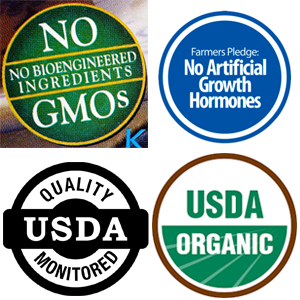Food Labels, What Do They Really Mean?
 If you are anything like me, walking through the grocery store and reading all the labels on food can be a bit daunting. What exactly does “raised without antibiotics” or “non-GMO” labels tell you about the food you are about to purchase? I did a bit of research to better understand these food labels. Here is what I found…
If you are anything like me, walking through the grocery store and reading all the labels on food can be a bit daunting. What exactly does “raised without antibiotics” or “non-GMO” labels tell you about the food you are about to purchase? I did a bit of research to better understand these food labels. Here is what I found…
There are 3 categories of “claims” that can be placed on food labels.
- Health claims: These claims describe a link between a certain food and its reduced risk of a disease or health related condition. Examples of these are “lower sodium intake results in lower blood pressure”, “high fiber containing grains/fruits/vegetables lower your risk for cancer”, and “high intake of calcium/vitamin D lowers your risk for osteoporosis”.
- Nutrient content claims: These claims refer to the amount of a nutrient that is found in a certain food. Examples of these are: “a good source of calcium”, “rich in vitamin C”, and “a low-sodium food”.
- Structure/function claims: These claims describe a role that a certain nutrient would play in a bodily function. Examples of these are “calcium builds strong bones”, “fiber maintains bowel regularity”, and “vitamin A protects your eyes”.
Nowadays, food labels not only include what is inside the food but also how the food was grown, raised, or processed. Some of these labels can be a bit confusing and hard to understand, so I have clarified some common examples of these below.
GMO claims
GMO stands for genetically modified organism. Some food manufacturers wish to label their products that do not contain GMOs; however the FDA closely monitors this. Other food manufacturers are labeling their foods with “made with genetically modified ingredients”. These new labels are meant to inform the consumer that the food contains GM ingredients, a new law enforced in Vermont. Food manufacturers all over the country are gradually adding this label to increase transparency with their customers.
Antibiotic claims
Antibiotic claims are regulated by the United States Department of Agriculture (USDA), and only used on red meat, poultry, and egg products. In order to have the “no antibiotics” label, the manufacturers must provide documentation that the animal was raised without ever receiving antibiotics. Milk can never be sold from an animal that has received antibiotics, so milk producers never need to use these labels.
Hormone claims
Hormone use is regulated by the USDA and varies with the type of animal. “No hormones administered” can be placed on a beef label if the producer proves that no hormones were added during the growth of their cattle. Pigs and egg-laying hens are never allowed to receive hormones so there is no need for these labels on pork products or egg products.
Organic
There are four categories for labeling foods organic.
- Any product that is 100% organic (excluding water and salt) may contain the “USDA organic seal” or “100% organic” claim.
- Any product that contains a minimum of 95% organic ingredients and up to 5% non-organic ingredients (excluding water and salt) can be labeled “Organic”.
- Any product that contains at least 70% organically produced ingredients can be labeled with “Made with organic _____” and list up to three organic ingredients.
- Any product that contains less than 70% of organic ingredients may list the organic ingredients on the information panel, however they are not allowed to display the USDA organic seal or the word “organic” anywhere on the main label.
Good/Excellent Source
If a food contains 10%-19% of the daily value of a certain nutrient, the manufacturer can label the food as a “good source.” If a food contains at least 20% of the daily value of a certain nutrient, the manufacturer can label the food as an “excellent source.” Some examples of these labels are: “orange juice is an excellent source of vitamin C”, “milk is an excellent source of calcium”, and “cereal is a good source of iron”.
Now that you know more about food labels, you will be an informed shopper! Give yourself a quick review of this information before you head to the grocery store and your next shopping trip will be a breeze!
-Nutrition Student Cara

